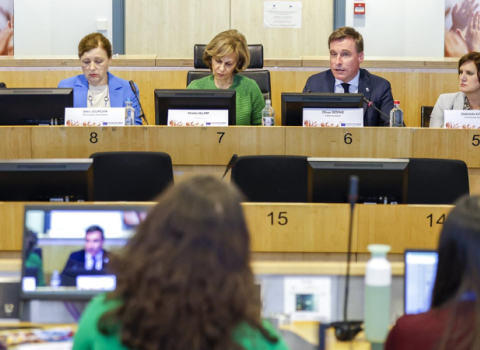Research stakeholders agree that the ERA Act should go beyond current voluntary efforts, but must work to secure the support of governments

EU research Commissioner Ekaterina Zaharieva. Photo credits: Denis Lomme / European Union
Research Commissioner Ekaterina Zaharieva plans to present “an ambitious but realistic” proposal for the European Research Area (ERA) Act next year, as part of efforts to finally address the EU’s fragmented research system and barriers to mobility.
“If it’s an act which repeats more or less basic principles that we have already in the treaties, I don’t see a big sense of proposing this act,” she said at the European Commission’s Research and Innovation Days conference on September 17.
European policymakers have long worried that national rules and systems were impeding scientists and innovators from collaborating across Europe’s internal borders. The ERA was conceived in 2000 to address this, but its largely voluntary initiatives have failed to create the desired single market for research and innovation. The goal of the ERA Act is to create legally binding obligations that will make it a reality.
The proposal was initially due in 2027, but Zaharieva said that she had pushed for it to be brought forward to 2026, so that the legislation can be finalised before the end of the current EU political mandate.
Per Zaharieva, the upcoming act will include minimum requirements for the career development of researchers, address the free movement of researchers and knowledge, and provide incentives for industry and public authorities to reach the long-standing target of investing 3% of GDP in R&D.
“I personally feel that, if we want to be competitive, this target is already low, but we are still not there,” she told conference delegates.
Meanwhile, stakeholder groups have been sharing their wish lists for the ERA Act, in response to a Commission call for evidence on this new legislation.
Investment hike
To address the pressing issue of insufficient funding, the Commission intends to introduce incentives to bring R&D investment up to 3% of GDP. So far, the EU has fallen short of this target, reaching a reported 2.22% in 2023.
For Science Europe, achieving this objective implies solving investment disparities by supporting underperforming member states, including by helping them reduce their reliance on EU funds. In addition, the association recommends promoting the use of the EU’s economic and fiscal framework, providing that the measures are not deemed in breach of fiscal rules.
The European Council of Doctoral Candidates and Junior Researchers suggests the creation of a national escape clause allowing governments to exceptionally deviate from their budgetary plans and ramp up R&D spending. This would mirror the escape clause already in place for defence spending.
Meanwhile, the European Association of Research and Technology Organisations believes that the EU must dedicate a substantial share of its investments to industry-driven research and innovation in order to leverage private funding. It cites Finland as an example, where the R&D Funding Act states that every invested public euro should bring €2 of private money.
The Coimbra university network and the Brussels representation of INESC institutes, a group of Portuguese research and technology organisations, both say that the 3% target should be binding. The League of European Research Universities (LERU) goes one step further and calls for a legally binding target of investing 4% of GDP.
During a panel discussion at the conference, LERU secretary general Kurt Deketelaere urged the Commission to propose a regulation, not a directive, meaning that the legislation would apply directly across the EU rather than leaving it to member states to transpose its measures into national laws. The EU must ensure that member states clearly reform their national research systems. “Play time is over,” he said.
However, Deketelaere agreed with Zaharieva on the need to be realistic. Recommendations for “long lists of topics on which the EU should regulate” are a “dead-end street,” he explained. “At the end of the day, this has to be approved by the member states, and so that means that we have to respect also their competences in this field.”
Funding alignment
That is where the Commission’s second building block of the ERA Act comes into play.
Considering the differences of economic development and the maturity of innovation ecosystems between member states, the legislation will look to better align EU and national funding and focus research support on strategic priorities.
“Insufficient strategic alignment between EU and national funding programmes, especially with regard to co-financing, hampers companies’ participation,” according to a submission from the Austrian Federal Economic Chamber. It goes on to underline the need to provide companies with predictability, transparency and access to EU programmes. “Strategic investments should focus on current challenges such as digitalisation, quantum technologies, AI, green tech, life sciences and robotics,” it adds.
Related articles
- Commission to launch public consultation on ERA Act
- Commission analysis lays bare fragmentation of European innovation
For Robbert Dijkgraaf, president-elect of the International Science Council and former Dutch science minister, the act should embrace values such as academic freedom and inclusivity and research topics that are coming under pressure in parts of the world. “I would love to see enshrined also that Europe commits itself to such subjects as public health, climate change, social inequality and diversity,” he told conference delegates.
As for increasing investments, the framework must be inclusive, according to feedback from the EU-funded Policy Answers project. It focuses on the Western Balkans, where institutional fragility, limited research infrastructure and low participation in European projects hinder the convergence with EU standards, it said.
Research circulation
The Commission’s third objective consists of improving the working conditions of researchers and bolstering the circulation of knowledge and talent across Europe, in line with former Italian Prime Minister Enrico Letta’s plans to have the ERA embody the “fifth freedom.”
“Most researchers [. . .] do in fact want their work to be used in some way or another, and this includes utilisation outside academia,” the University of Copenhagen says in a statement. “But [. . .] valorisation takes time, and often needs further development in collaboration with lead users before it can be further exploited and lead to social impact,” it goes on. “Such activities can be costly and the act needs to take this into account.”
Claire Fritz, coordinator of the Commission’s European Intellectual Property Helpdesk, confirms that valorisation, alongside skills in intellectual property, are unevenly available within the EU. “The ERA Act should promote integration of these competences into doctoral training and mobility schemes, with indicators for uptake and gender balance,” she says in a submission.
Many stakeholders agree on the need for a uniform visa regime, in addition to current efforts by the Commission to speed up procedures for third-country scientists moving to the EU. “Mobility must come with rights: faster recognition of qualifications, portability of pensions and benefits, and predictable residence and long-stay visa procedures,” two European education unions say.
Finally, Corvinus University of Budapest highlights the importance of supporting research beyond shifting national political agendas if Europe is to continue protecting academic freedom.





 A unique international forum for public research organisations and companies to connect their external engagement with strategic interests around their R&D system.
A unique international forum for public research organisations and companies to connect their external engagement with strategic interests around their R&D system.